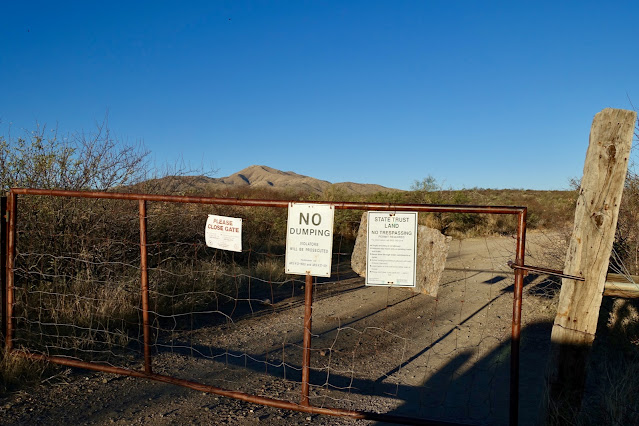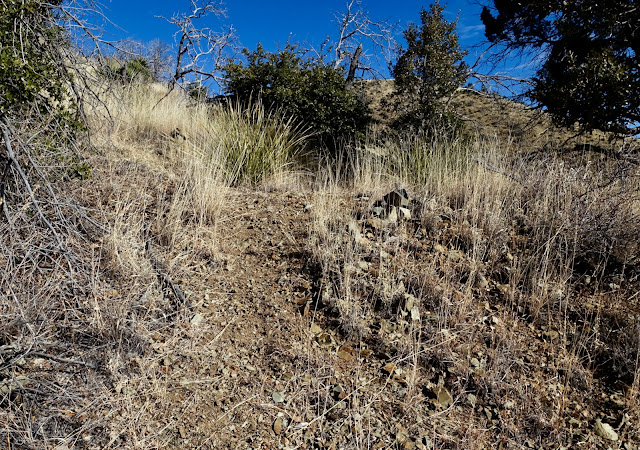Essence: From Interstate-10 southeast of Tucson, in winter light Mount Fagan has luscious soft furrows, long shadows, and golden hues. With 1,009 feet of prominence, this is the last peak of significance in the northern tier of the Santa Rita Mountains. Approach from the east on public lands: Arizona State Trust Land and Coronado National Forest. Unless you have a 4X4 rock-crawler, you will be walking for up to four miles on a two-track before launching off-trail. An elegantly arced ridge leads to the peak with its extraordinary view. This cairn-free hike requires some navigation savvy.
Travel: From I-10, take Exit 281, signed AZ-83 South, Sonoita/Patagonia. Measure distance from the stop sign at the end of the eastbound off-ramp and turn south on AZ-83. Pass Sahuarita Road. The highway makes a big swing from southeast to southwest at Mile Marker 53. Pass Charron Vineyards. Pass Mile Marker 52. At Mile Marker 51.4, turn west at a gate posted State Trust Land, Permit Required. This is just south of Twin Tanks on the Mount Fagan topo. Open and close the gate. Most vehicles should park. Dedicated 4WD is required for the trenched and rocky road; drive as far as you are comfortable. Upon entering the National Forest at 2.9 miles, the track is ridiculously steep. Post your State Trust Land permit.
Distance and Elevation Gain: From AZ-83, 10.5 miles; 2,900 feet
Total Time: 5:00 to 7:00
Difficulty: Jeep track, off-trail; navigation moderate; Class 2; steep road and slopes, no exposure; carry all the water you will need; hike in the winter to avoid rattlesnakes and bees.
Map: Mount Fagan, AZ 7.5' USGS Quad
Date Hiked: February 7, 2022
Difficulty: Jeep track, off-trail; navigation moderate; Class 2; steep road and slopes, no exposure; carry all the water you will need; hike in the winter to avoid rattlesnakes and bees.
Map: Mount Fagan, AZ 7.5' USGS Quad
Date Hiked: February 7, 2022
Reference: Thank you Surgent for turning us on to this hike and for the cautionary note on the technical road.
Quote: Beware, O wanderer, the road is walking too. Jim Harrison
Quote: Beware, O wanderer, the road is walking too. Jim Harrison
The true summit of Mount Fagan and most of the route is seen from the beginning of the road. The free-range, upper portion of the hike is the most pleasurable. Yet, the long journey on the track has a mellow, sauntering, Zen effect--provided you don't get lost in the maze. (Thomas Holt Ward, photo)
Route: From AZ-83, bear west staying on the main track to The Lake. Several roads and arroyos converge. Take the track up the west fork. Stay with the main road as it swings in an arc northwest, southwest, and finally south. Just before Point 5,102', descend on a branch to the west. From the saddle, pitch up Point 5,420' off-trail. Climb the northeast ridge to the peak.
From parking, elevation 3,985 feet, ignore converging roads and bear due west. The rounded crest of Mount Fagan can be seen from the parking area but soon it is obscured by a false summit. Cross a Twin Tanks feeder wash in half a mile. A track joins from the right and the Arizona Trail crosses the road at about 0.6 mile; continue straight.
The approach and the mountain are contained within the semi-desert grassland ecosystem. The rolling landscape is verdant with whitethorn acacia and mesquite, soaptree yucca, ocotillo, and prickly pear. Wildflowers were in a deep sleep the first week in February. As for the road, boulders and smooth cobbles have collected in the ruts. Moguls are massive as the track closes in on The Lake. Take any of the work-arounds.
Arrive lakeside at 1.9 miles. Water was low in the dammed catchment, a couple of ancient cottonwood trees were dormant, and cattle were ambling in for a drink. (THW, photo)
Two drainages feed The Lake, one from the south, another from the west. Walk up the dry streambed bearing west. We made two incorrect navigation moves which I have left on the map because they are instructive. The roads looked plausible but they went off to the south. These cows, a fraction of the large herd, were our welcoming committee.
Walking was easy on the gravely wash bottom. We passed a cluster of coyote melons, members of the gourd family. White longitudinal lines decorate lemon-yellow spheres.
The road pulls out of the arroyo at 2.2 miles and swings to the northwest to gain a small interior ridgeline. It's going to feel like you are pointed away from the mountain but the road is simply going from ridge to hill to the north ridge of Point 5,102'. Resist the urge to cut cross-country. There are many pertubations, small pocket ravines, in the landscape. Besides, rattlesnakes are alive and well here in warmer months. Spot them on the road more easily than slithering through grass. Top out on the ridgelet at 4,420 feet. (THW, photo)
Mount Fagan is a volcanic mass protruding from surrounding sedimentary conglomerates. The transition in rock composition takes place in this area. Cobbles are exchanged for chipped rhyolite and volcanic tuff bedrock. Give up 40 feet transitioning from the ridge to the next hill with more significant undulations to follow. In the depression at 2.9 miles, the road passes from State Trust Land to Coronado National Forest. Open and close the gate. This is not an engineered road, but it is efficient. You are going to feel like a rock-crawler while climbing the next ultra steep and trenched pitch. Trekking poles are helpful. At the top a track comes in from the north at 4,580 feet.
While standing on the hilltop we saw two bighorn sheep take off running. Transition to the north ridge of Point 5,102' with another drop and climb. We passed by a barrel cactus family, sunburst sotol, and glistening beargrass. The lofty ridgeline looks out over The Lake in the ranging valley and the Empire Mountains east of AZ-83. (THW, photo)
The road ends on Point 5,102', a minor outpost at the end of this small ridge (image-center, below the horizon). It's worth the quick hop to visit the knoll coming or going.
The route to Mount Fagan leaves the ridge just shy of Point 5,102' at 4.0 miles. Pause to analyze the route from here. A track drops steeply west to the east base of Point 5,420', image center-right. The climb is off-trail from the saddle, staying to the right of the ravine. From the marked point simply follow the ridgeline to the summit. On our hike buckaroo windblasts were ferocious. We debated whether to continue. We'd come this far...so onward.
From the saddle at 4,940 feet, there is a promising trail to begin but it quickly threads and disappears on the broad hillside. We loved the off-road segment of this adventure. However, the 500-foot, 0.3 mile haul up Point 5,420' was the most difficult stretch. (The descent was even more laborious.) The moderately steep incline pitches up more radically as you go. Footing is good; rock stays fairly well seated while wading through the grass. It's easy enough to dodge prickly pear and agave. The cresting golden dome contrasts with the cerulean skyscape.
Compared with the taller stone summits in the Santa Rita Mountains, Mount Fagan is a rolling hill. Yet, its sublime arc calls out to the aesthetic.
Descend 40 feet into a minor saddle and locate a faint social trail. The footpath comes and goes but it stays on the ridgeline. There's an exhilarating sense of being on a ridge, yet it is free of obstacles and exposure. Ascend through a grove of Arizona oak.
There are many spectacular agave scattered across the land. We awarded grand prize to this ball of spears. Palmer's agave is common in the Santa Rita Mountains.
Arrive on the broad, grass-covered mountaintop at 5.2 miles. I love this relatively humble summit. There is an incomparable view of its companion peaks to the south. Captured below, Josephine Peak is tucked behind and to the left of Mount Wrightson; working up the south ridge are McCleary Peak, 88 Mac, and Mount Ian; and to the west is Pete Mountain. (THW, photo)
Fagan benefits from the donut phenomenon--the peak is an island surrounded by desert sea. We were spellbound by the entire length of the Rincon Mountains: Tanque Verde Peak dwindling onto the desert floor, Mica Mountain with its highpoint that goes on forever, the bald summit block of Rincon Peak, and even North Star Peak in the Little Rincon Mountains. The vista encompasses all the familiar sky islands in and around Tucson.
West and slightly south of the mountain is the active Imerys Marble Quarry (Santa Rita Limestone Quarry). Paleozoic limestone was subject to metamorphism and transformed into marble. The white marble deposit is faulted and fractured, and 300 to 500 feet thick.
The peak is named after Michael Fagan. He started out as a prospector but sold his mine in 1880 and became a cattleman operating in the Huachucas and Santa Ritas. We searched for the "Faggan" benchmark unsuccessfully. It is presumably buried under the summit cairn which serves as a memorial for the Stump family of Tucson. The peak register was sparse but notable. In October of 2020, a deer hunter went into shock after a bee sting and was evacuated from Fagan by helicopter. One gnarly person tackled the road on his bike.
Click on the image below to see an overview of the return from the peak. Descend on the ridge trail, go up Point 5,420' and
down the other side. Pitch up the road to the ridge just north of Point
5,102'. Climb the little knoll. Descend the north ridge on the road and
rewind back to The Lake and out to the highway.



















































